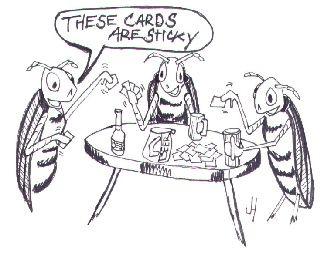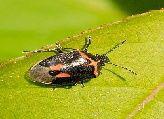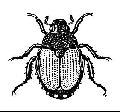Natural Solutions to Things That Bug You (47 page)
Read Natural Solutions to Things That Bug You Online
Authors: Myles Bader

COFFEE TO THE RESCUE
Place old coffee grounds; around plants that are susceptible to flea beetles. This works very well!

CUT THE DECK
Flea beetles can be trapped using playing cards that have been smeared with a sticky substance like Tanglefoot™ or non-drying glue. You can place a small amount of beer in a shallow dish in the center of four cards placed around the dish to attract them. Flea beetles love beer, especially Coors™.
GETTING A BIT MISTY
You can dust your plants to keep the flea beetles off by using wood ashes mixed with lime, but be sure that you mist, all the plants first so that the dust will adhere.
FLEA RESISTANT VARIETIES
There are a number of plants that you can plant that are resistant to flea beetles. These include De Cicco, Atlantic and Italian green sprouting broccoli, Snowball cauliflower, Mammoth, Red Rock and Early Jersey Wakefield cabbage and Sequoia potatoes. Check with your local garden supply store for other varieties.
BEER TRAP
Place cheap beer in a shallow dish and bury it allowing the dish to just remain above ground making it easy for the beetle to get into the beer and drown. A number of bugs are attracted to beer. They are actually more attracted to malt liquor than they are to beer.
HIRE A TOAD
Toads love flea beetles and will eat all stages of this bug. Other ground beetles and wasps will also hunt them.
FLOUR BEETLE
General Information:

 The flour beetle was found in the tombs of ancient Egypt and will consume a variety of foods. They love grains, beans, peas, candy, nuts and dried fruit. The most common of these beetles is the red flour beetle. They do not require water to survive and lay sticky eggs that hatch and crawl to the top of grains and look like small white pupae. Discard any food if you find any sign of this beetle or its offspring. They have the ability to excrete a bad smelling chemical that contaminates the foods they inhabit.
The flour beetle was found in the tombs of ancient Egypt and will consume a variety of foods. They love grains, beans, peas, candy, nuts and dried fruit. The most common of these beetles is the red flour beetle. They do not require water to survive and lay sticky eggs that hatch and crawl to the top of grains and look like small white pupae. Discard any food if you find any sign of this beetle or its offspring. They have the ability to excrete a bad smelling chemical that contaminates the foods they inhabit.
Freezing the foods will kill them but it is already too late
GETTING TO THE ROOT OF THE PROBLEM
Rhizomes, roots of turmeric have been used for centuries to ward off these bugs and works great when left on the shelves in the pantry.
Fenugreek placed out also works very well. These just repel the bugs and will not kill them.
HARLEQUIN BUG
Identification:
 These bugs are either black and red or black and yellow and suck plant juices. They lay barrel-shaped eggs on the underneath side of leaves. Harlequin bugs: can be identified by the bleached areas they leave on the leaf when they feed.
These bugs are either black and red or black and yellow and suck plant juices. They lay barrel-shaped eggs on the underneath side of leaves. Harlequin bugs: can be identified by the bleached areas they leave on the leaf when they feed.
General Information:
They spend the winter in old leaves and trash. Good reason to clean up the yard before the first snow. They are one of the prettiest bugs in the insect world. They love turnip seedlings and if they are not controlled you will never get a turnip. They also like to eat Brussels sprouts, cauliflower, kohlrabi, horseradish, broccoli and mustard.
ONE BUGGY, TWO BUGGY
Handpicking the bugs is one of the best methods to get rid of them. Handpick both the bugs and their eggs. If you can find a praying mantis you might ask for some assistance since they like to dine on these beetles. Insecticide soap sprays will also do the trick in short order.
PLANT BUG RESISTANT VEGGIES
There are a number of vegetables that have been developed that are resistant to this bug. They are Grande, Atlantic and Coastal broccoli; Copenhagen Market 86, Headstart, Savory Perfection Drumhead, Stein’s Flat Dutch and Early Jersey Wakefield cabbage;
Early Snowball X and Snowball Y cauliflower; Vates, Morris Improved Heading and Green Glaze collards; Vale kale; and Red Devil, White Icicle, Globemaster, Cherry Belle, Champion and Red Prince radishes.
JAPANESE BEETLE
Identification:
 This is a metallic green beetle with copper-colored wing covers. There are small tufts of short, white hairs under the wings and gray hairs on the underneath side. They are about ½ inch long and ¼ inch wide. The males are a little smaller than the females.
This is a metallic green beetle with copper-colored wing covers. There are small tufts of short, white hairs under the wings and gray hairs on the underneath side. They are about ½ inch long and ¼ inch wide. The males are a little smaller than the females.
General Information:
 The beetle is normally found in the eastern United States but is moving west. May be found almost anywhere in woods and gardens. They usually feed on only one plant and will not bother another one. They like the sunlight and will feed more in temperatures between 83
The beetle is normally found in the eastern United States but is moving west. May be found almost anywhere in woods and gardens. They usually feed on only one plant and will not bother another one. They like the sunlight and will feed more in temperatures between 83
and 95
F. The beetle lays their eggs in early August, which is the best time to do some tilling.
AN UNWELCOME VISITOR
The Japanese beetle migrated to the United States around the turn of the century, probably in the root system of a plant. The beetle spends 10 months of the year in the ground in the form of a white grub.
 Their white grubs feed on tender roots and grass and are the most common white grub in the eastern United States. Every species of white grub can destroy lawns and leave large brown areas. They winter in the soil until the spring and their period of greatest activity lasts from 4-6 weeks.
Their white grubs feed on tender roots and grass and are the most common white grub in the eastern United States. Every species of white grub can destroy lawns and leave large brown areas. They winter in the soil until the spring and their period of greatest activity lasts from 4-6 weeks.
They are not fussy eaters and will consume almost any type of plant they come upon. Their favorites, however, are rose bushes, purple plum trees, cherry trees and myrtle. They will mass on ripening fruit and eat until nothing edible is left.
Most beetles will lay their eggs in the grass and one excellent method of reducing or eliminating the problem is to treat the grass with a killer in early spring before they hatch.
Japanese beetles are not fussy eaters and there are over 280 plants that they will dine on if given the chance. They leave the leaves of plants skeletonized.
THE ELIMINATOR
The following ingredients will be needed:
1 Pound of hydrated lime (use with caution)
5 Ounces of alum
10 Gallons of cool tap water
Place the water in a large bucket; then add the other ingredients slowly while stirring well. Place the solution in a sprayer and spray the tops and bottoms of the leaves.
This solution is poisonous and should be kept away from humans and animals. Use with caution and wear gloves.
SPRINGTIME WITH NC NEMATODES
If you spray the lawn with Nc nematode spray in the spring it will eliminate the problem of grubs munching on your grass stalks for lunch. You can also spray pyrethrums or use a garlic and onion spray.
